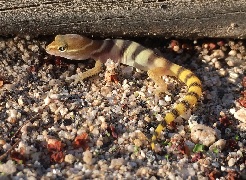San Diego Banded Gecko (Coleonyx variegatus abbotti)
Description: 2 to 3 inches long from snout to vent.A small, slender lizard with movable eyelids and vertical pupils. The head is triangular in shape and wider than the neck, and is usually not spotted, but dark in color. There is a narrow, light collar mark, extending from the eyes to the collar. The skin is soft with fine granular scales (without tubercles). Toes are long and slender. Tail is constricted at the base. Color pattern is variable, with a pale yellow, pink, or light gray background, and tan or brown bands on the body and tail. These bands typically are uniform in color and do not break up into blotches as they do on adult C. v. variegatus. The width of the dark bands is equal to or narrower than the width of the light areas. Males have spurs on each side of the base of the tail. Juveniles tend to have more prominent unbroken bands.
Habitat: Prefers rocky areas in coastal sage and chaparral.
Range: The subspecies C. v. abbotti ranges from coastal southern California south into Baja California to just north of the Viscaino Desert where it intergrades with the Mexican subspecies, C. v. peninsularis. In California, C. v. abbotti is found in the interior southern coastal region, west of the Peninsular ranges and south of the Transverse ranges.
Found in these States:
CA
Diet: C. variegatus preys on small insects and spiders, and is one of the few reptiles that control scorpion populations by eating baby scorpions.
Reproduction: The Western banded geckos breed during the months April and May. During the months of May through September, the female western banded geckos will lay one to three clutches of eggs. Each clutch of eggs contains two eggs. The eggs will then hatch in approximately 45 days.
Status: Listed as Least Concern in view of its wide distribution, presumed large population, and because it is unlikely to be declining fast enough to qualify for listing in a more threatened category.
»» Kingdom: Animalia - Animals
»» Phylum: Chordata - Chordates
»» Subphylum: Vertebrata - Vertebrates
»» Class: Reptilia - Reptiles
»» Order: Squamata - Lizards
»» Family: Gekkonidae - Geckos
»» Genus: Coleonyx
»» Species: Coleonyx variegatus - Western Banded Gecko
»» Subspecies: Coleonyx variegatus abbotti - San Diego Banded Gecko
This article uses material from the Wikipedia article "Western Banded Gecko", which is released under the Creative Commons Attribution-Share-Alike License 3.0. Content may have been omitted from the original, but no content has been changed or extended.
|













